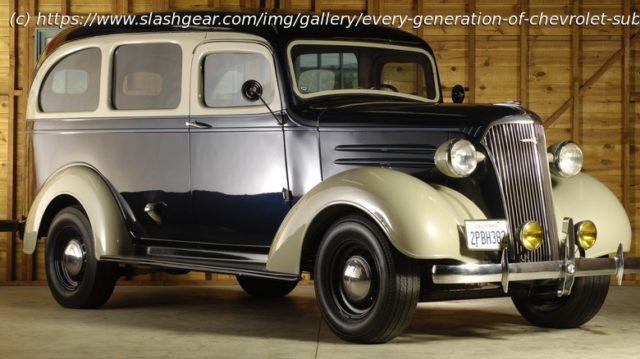The Suburban, Chevrolet’s signature SUV, continues to be a popular choice among consumers. But how does each generation rank and compare to one another?
In the early 1930s, the name “Suburban” referred to a classification of vehicles featuring a windowed body similar to a modern-day station wagon. Brands such as Dodge, Plymouth, and Studebaker manufactured models with the Suburban style. When Chevrolet introduced its steel-bodied, eight-passenger truck-based wagon in 1935, the Suburban nameplate seemed appropriate for the full-size, extended-length Sports Utility Vehicle (SUV).
The Suburban has evolved over the years making changes and incorporating new technology to improve power output, road handling, and passenger comfort. While the base model Suburbans offer an average-performing suspension, the optional magnetic dampers give the SUV a smooth Cadilac-type ride. For off-roading, Chevy now offers the Z71 trim with exceptional capabilities for challenging dirt and mud roads. However, the SUV has one feature that remained constant through the years: its massive size. The current Suburban models offer three rows of comfortable seating for up to eight passengers and have a cargo space that exceeds that of the Jeep Wagoneer by an impressive 20 cubic feet when both vehicles have their third-row seats folded.
Car and Driver calls the Chevy Suburban the quintessential American vehicle: “big, brash, potent, and pragmatic.” Recent vehicle sales back up this claim. In 2021, Chevrolet sold 48,214 Suburbans, and in the following year 50,951 vehicles, a gain of 5.68%. Although the Suburban has demonstrated progress with each new generation, some have been more successful than others.
Based on innovative features introduced, auto industry reviews, NHTSA statistics, and owner feedback, here is every generation of the Chevrolet Suburban ranked from worst to the best.12. Chevrolet Suburban Second Generation 1941 – 1946
The second-generation Suburban ranks as the worst for its low production and lack of new features. During World War II, the manufacture of military products and vehicles for the war effort severely impacted the production of automobiles available to the public, and the Suburban was no exception. Chevrolet produced nearly 3,000 armored cars, manufactured aircraft engines, gun parts, and shells, and worked as a Grumman Aircraft subcontractor on wing sections and fuselage components. The automaker’s commitment to military vehicles and equipment limited the commercial production of new second-generation Suburban models to the years 1941, 1942, and 1946.
During the war years, Chevrolet offered two variants for the Suburban, one with rear panel doors and the other with tailgates replacing the panel doors. However, when American auto manufacturers reverted back to making automobiles from war materials in 1946, they had no designs for new models. Production instead resumed with the 1942 models.
The 1946 Chevrolet Suburban’s exterior styling was identical to the 1942 form, and the early units even lacked war-rationed chrome trim, but it showed up again on the vehicles produced later in the year. The same Stovebolt six-cylinder engine provided the power, albeit with a slightly greater displacement of 228 cubic inches and a higher output of 90 hp at 3,300 rpm and 165 lb-ft at 1,000-2,000 rpm. Power was sent to the rear wheels via a three-speed manual transmission and Chevy continued offering hydraulic brakes as standard equipment.11. Chevrolet Suburban Ninth Generation (GMT800) 2000 – 2006
Chevrolet built the massive ninth-generation Suburban on the same robust chassis used for the GMC Silverado and Sierra pickup. The rugged SUV tackled dirt roads laden with holes and ruts, conquered challenging offroad terrain, and pulled heavily loaded trailers. However, the Suburban’s performance on winding roads was mediocre, and no buyers selected the vehicle for its fuel efficiency. In 2000, Chevrolet completely redesigned the Suburban offering better road handling from a more ridged frame, an upgraded interior, a 5.3-liter V8 engine producing 285 hp in the 1500 model and a 6.0-liter V8 generating 300hp in the heavy-duty 2500 weighing 5,760 pounds.
But what makes the ninth generation rank low on the list of best Suburbans are the brakes. Owners reported a variety of issues including failure to work properly, the short brake pad life of three to four months, vibrations, noise, and an anti-lock braking system (ABS) that activates without warning. The NHTSA website registered several reports on the brakes. “When driving at any speed and applying the brakes, they freeze up, one report said. “Brake pedal is barely touched and brakes lock instantly causing occupants to jolt forward ABS is working intermittently.”
Another report noted that the brakes failed completely, with the pedal hitting the floor after pulling into a parking lot with no rebound.
[Featured image by IFCAR via Wikimedia Commons | Cropped and scaled | Public Domain]10. Chevrolet Suburban First Generation 1935 – 1940
The first-generation Chevrolet Suburban has its roots in an eight-seater vehicle made with a wooden body mounted on a half-ton truck frame. The vehicle was first built in 1933 for the National Guard and Civilian Conservation Corps units. In 1935, Chevrolet introduced the first Suburban to the public, a rugged, no-nonsense load-carrying model featuring an all-metal station wagon body fitted with either rear panel doors or a tailgate on the chassis of a small truck. Although many consider it to be the first SUV, the Suburban was still a commercial vehicle. Passenger car features such as a heater, dual windshield wipers, a clock, and a radio were offered as options.
The early first-generation Suburban came in a two-door body style with a 3.4-liter inline six-cylinder “Stovebolt” engine (so-called for its large, slotted-head fasteners that resembled those in popular wood-burning stoves), producing 56hp. In 1937, Chevy upgraded the engine to 79hp at 3,200 rpm and a maximum torque of 140 pound-foot at 1,000-2,000 rpm. Power was sent to the rear wheels via a three-speed manual transmission.
In addition to the ample passenger seating, the foldable second-row and removable third-row seating provided the Suburban with a maximum of 115.1 cubic feet of cargo space. In 1936, Chevrolet improved safety by introducing hydraulic brakes, and in 1937 the body was streamlined with an Art Deco styling. Although the first generation could be considered one of the best, mainly because it introduced the Suburban which became the Chevy’s longest-running production vehicle, without interruption, its features pale in comparison to other generations.9. Chevrolet Suburban Third Generation 1947 – 1954
Chevrolet introduced the third generation Suburban with its “Advance Design” styling used on the Chevy truck line, although it displayed many of the vehicle’s traditional design characteristics employed since 1948. The exterior featured a sloping windshield, wide horizontal grille bars, running boards, and a massive hood that made the huge front fenders seem just a bit smaller. Like the previous generation, the new Suburbans offered the two-door body style with access to the cargo area either by a pair of “barn” doors or a tailgate.






